Hoya Krimson Queen vs Princess: What Are the Differences?
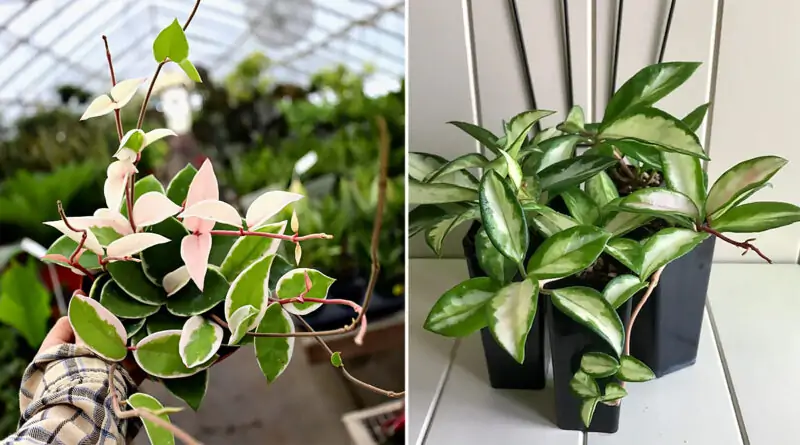
Are you in the market for a new houseplant that will bring life and color to your home? Look no further than the Hoya genus! Specifically, let’s explore the differences and similarities between two popular varieties: Hoya Krimson Queen vs. Princess.
The Hoya Genus
Before we dive into our comparison of these two plants, let’s take a look at what makes up the Hoya genus. These plants are native to tropical regions of Southeast Asia, Australia, and Polynesia. They’re commonly known as “wax plants” due to their thick waxy leaves.
What’s more, while your Hoya Krimson Queen (or Krimson Princess) leaves look absolutely stunning, these plants have more to offer than merely unique foliage patterns. When it comes to the flowering season, hardly anything can be compared to your Hoya Krimson Queen or Princess beautiful blooms that can last for weeks. Some species of Hoya even produce fragrant flowers that add an extra layer of sensory appeal.
Hoya Krimson Queen vs Princess Overview
Now onto our featured players: let’s start by taking a closer look at each variety:
Hoya Carnosa Krimson Queen
This cultivar is known for its striking variegation – dark green leaves of the Krimson Queen with their characteristic pink edges adding visual interest both when it blooms or not. It’s important to note that those traits may vary depending on the light exposure of your tropical plant or the climate changes around it. The Krimson Queen produces small clusters of white-pink flowers with red centers during active blooming periods, which usually take place from late winter until early summer every year.
Hoya Carnosa ‘Krinkle 8’ or ‘Karlo’
Contrary to what some people might think, they aren’t actually hybrids but rather different varieties within the same species originating from Eastern Asian countries such as China, India, and Vietnam. They have mostly similar characteristics, growth habits, and care requirements.
Hoya Carnosa Krimson Princess
One distinguishing feature of this Hoya is that its leaves are more elongated and thinner. The color of the leaves, while still variegated, is less striking than that of the Hoya Krimson Queen leaves. It’s also worth mentioning while both the Queen and the Princess have flowers that look almost identical, their blooming periods are different. The Queen wears her white and pink flowers from late winter until early summer, whereas the Krimson Princess has a shorter season from spring to summer.
Difference Between Hoya Krimson Queen and Princess
Now for what you’ve been waiting for: let’s examine some key differences between these two varieties.
Classification and Taxonomy
Despite being two separate cultivars with slight variations in appearance due to climate or light exposure conditions, both belong to the same “hoya carnosa” species. This means that whether you’re growing either Krimson Queen or Princess, you don’t have to significantly modify your routine as both plants have almost the same care requirements: in fact, both Hoyas are very easy to care for.
Leaf Color and Texture
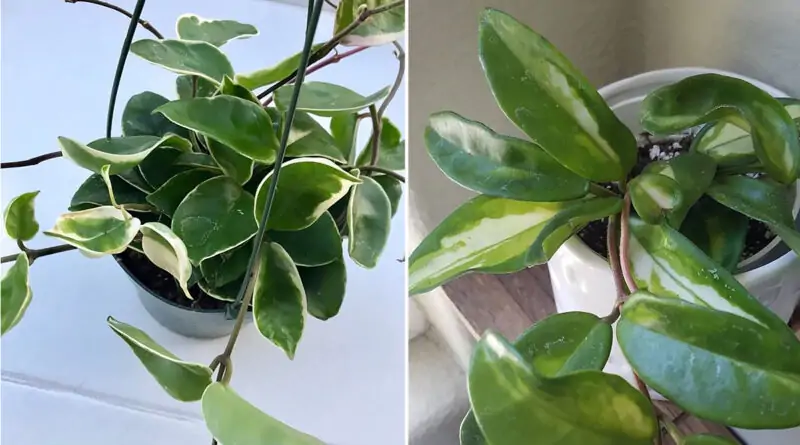
The main difference between Hoya Krimson Queen and Princess is their leaf color. As previously noted, the Hoya Krimson Queen’s leaves are dark green with pink edges, with coloration varying depending on sunlight amounts. In contrast, the Hoya Princess has a lighter green pigment in its leaves which results in more toned-down colors with pale pink or white edges.
Regarding texture, there isn’t much contrast, although it may be mentioned that after years of growing, ‘Krinkle 8’ tends to develop thicker, dimpled, rubbery leaves with different patterns or shapes like puckering.
Flower Characteristics
During active blooming periods both Hoyas produce white-pink blooms with smaller reddish-pink flowers in their centers. However, one notable distinction refers to their flowering cycles: The Krimson Queen’s bloom season lasts from late winter to early summer, making them ideal holiday gift options, especially among gardeners. Meanwhile, the Krimson Princess blossoms during the spring and summer months each year.
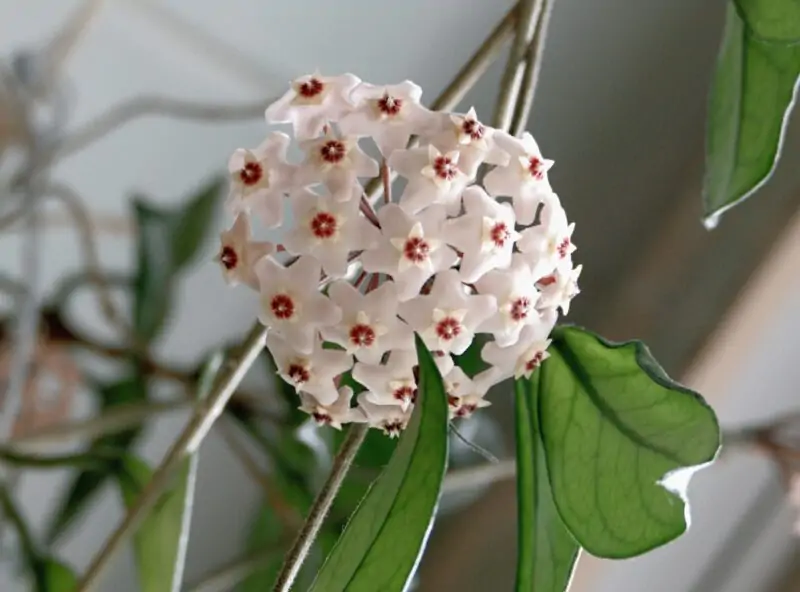
Growth Habit and Rate
On average, Hoyas are slow growers and need plenty of time to reach their maximum potential, but there is a slight difference between Hoya Krimson Queen and Krimson Princess.
Compared to Krimson Princess, Krimson Queen is recognized as a faster-growing cultivar. In fact, Hoya Krimson Queen can grow up to around 12 inches tall at maturity, while the Princess remains quite compact with an average height hardly exceeding 6-8 inches.
Height and Structure
Another important aspect that differentiates the Queen from the Princess lies within the plant’s structure itself. As previously noted, the Krimson Princess remains relatively small in stature, typically growing no taller than six inches or so. On the other hand, the Krimson Queen can reach more impressive heights, up to one foot, and pruning your Hoya genus is a much more viable idea when it comes to the Queen. Vines of this variety may be trained or pruned into various shapes thanks to their strong support systems.
Watering Frequency
Both plants have similar watering needs when it comes down to completely drying the top layer of soil. However, due to differences in their size and planting location – for instance, whether they’re in hanging baskets placed near a windowsill against hot sun rays that could cause evaporation faster or kept further from warm vents – you might want to water your Krimson Queen/Princess more or less frequently.
Is also very important not to overwater your Hoya: by doing so you protect the plant against root rot. Overhead watering your plant is generally not recommended as excess water on leaves can facilitate pest infestations.
Fertilizer Requirements
When it comes to feeding these versatile houseplants, both crave balanced feedings during the growing seasons. However, some recommend using an additional amount of fertilizer for boosting blooms (one that is high in phosphorus) periodically for the Krimson Queen’s overall performance.
Light Requirements
Just like the Queen, your Princess doesn’t need direct sunlight. In fact, both varieties appreciate bright indirect light year-round. An east-facing window works best since direct sun exposure can damage leaves. But under certain conditions like summertime months, full morning sunlight doesn’t seem to cause any issue if properly watered. Nevertheless, avoid placing your Hoya near extreme heat sources such as air conditioner vents or areas where drafts and dryness occur easily.
Price Comparison
Given the different unique features of these two popular Hoyas, pricing variations may occur. Generally speaking, the Queen is much more expensive than the princess. Therefore, depending on how much money you’re willing to spend will determine which type you choose: the Princess may be the only viable option for you budget.
Similarities Between Hoya Krimson Queen and Princess
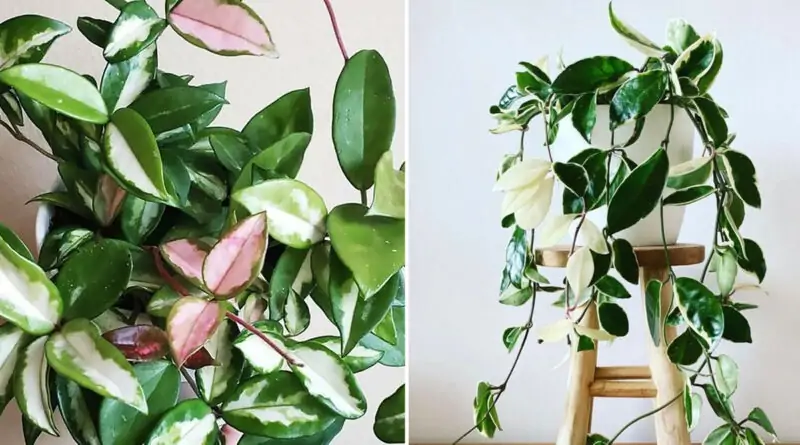
Now let’s take a look at what these two varieties have in common:
Flowering Process
Both Krimson Queen and Krimson Princess produce small clusters of white-pink or light pink flowers with red centers during active blooming periods. The blooms are fragrant, long-lasting, and can be enjoyed for weeks!
Temperature Preferences
Both varieties enjoy warmer indoor temperatures between 60-80°F year-round while preferring to avoid colder drafts or sudden temperature spikes.
Soil Preferences
A well-draining soil mixture with orchid bark/peat moss is ideal for both types; it’s good to remember they prefer moisture but not overly wet conditions which can cause root rot over time if left unattended.
Pruning Practices
Similar pruning techniques apply since Hoyas do grow vines that may get tangled requiring occasional untangling. However, don’t forget also to regularly check leaves’ health status, spotting off any dead or discolored parts as soon as possible because eventually, diseases can affect the whole plant quickly otherwise.
Repotting Guidelines
It should come as no surprise given their similar requirements – repot every few years when the roots start outgrowing the pot size, ideally doing so early in the spring just before the growing season ramps up again; keeping them in slightly larger pots compared to others houseplants due to their rooted growth system.
In conclusion, when comparing Hoya Krimson Queen vs. Princess, both plants have their unique features and charm. By understanding the key differences and similarities between them, you can choose the right Hoya for your home and enjoy their beautiful foliage and blooms.
Growing Requirements for Hoya Krimson Queen and Hoya Krimson Princess
Now that we’ve covered some key similarities and differences between these two popular cultivars let’s dive into what it takes to grow healthy and happy Hoyas:
Watering Practices
As previously mentioned, both plants require consistent watering schedules – preferably allowing the soil top layer to dry completely before each round! Extreme caution is necessary though when dealing with tap water depending on where you live. In some cases, rainwater or distilled water will be a much better choice. Add your monthly dose of fertilizer to the water throughout most seasons except winter to help your plant have all the necessary nutrients for healthy growth.
Sunlight Exposure
When it comes to lighting, indirect sunlight is ideal not only year-round but also during blooming periods. The Krimson Queen and Princess both love a spot near an east-facing window where they’ll get morning sun without too much heat during peak hours.
Fertilizer Application
As with many houseplants, Hoyas need consistent fertilizing schedules, especially in growing seasons (spring-fall). The best types of formulas should be well-balanced with the necessary nutrients; some gardeners recommend occasional boosted bloom cycles using diluted high-phosphorus fertilizer or bone meal. And remember that any excessive feeding could lead to root burn or drown your plant entirely, so don’t exceed the manufacturer’s recommended amounts.
Soil Mixtures and Drainage
A good soil mix will consist of orchid bark, peat moss, and perlite/vermiculite, chosen carefully considering drainage requirements. However, as previously noted, Hoyas shouldn’t remain sitting in water for long periods of time. Take care to avoid excessive moisture without neglecting their watering necessities altogether.
Pest and Disease Management
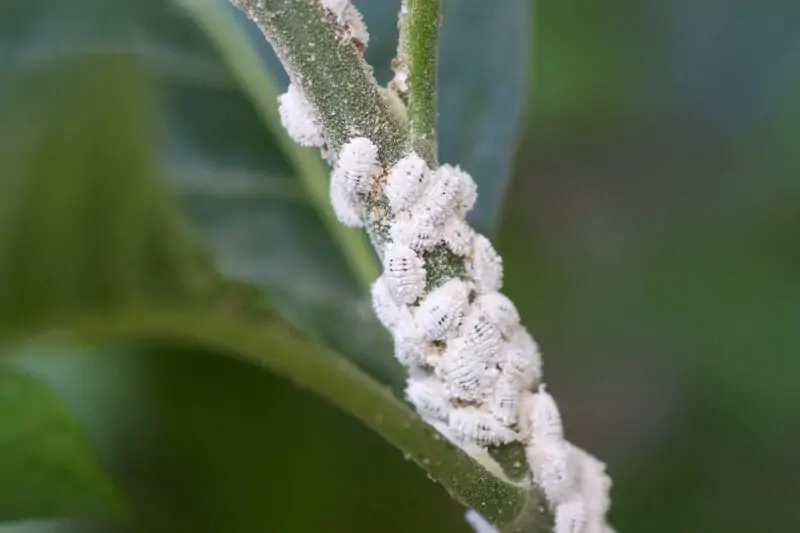
Hoyas are generally resilient plants, but there’s always a risk of encountering common pest problems such as scale, mites, or mealybugs, which are commonly attracted by dry indoor environments. These pests can be treated quickly and easily by applying proper insecticides and cleaning the foliage occasionally with spot treatment.
Regarding diseases, they are usually caused by overwatering or extreme temperature changes in most cases. Issues like fungal leaf spots or bacterial-related infections may manifest symptoms – yellow or blackish spots/decoloration. Upon noticing them, act fast by trimming off affected parts and moving the infected Hoya away from others for several days to keep an observation on its progress.
Care for your Krimson Princess and Queen Better: FAQs
Here are answers to some frequently asked questions about caring for Hoya plants:
Yes! Hoya plants should be repotted every few years when their roots outgrow the pot size. It’s important to use a well-draining soil mixture with orchid bark and peat moss, and to repot in early spring just before the growing season begins.
While humidity is important for Hoya plants, they don’t necessarily need to be misted. In fact, over-misting can actually cause damage by promoting fungal growth on the leaves.
Some gardeners have reported success using coffee grounds as a fertilizer supplement or pest deterrent. However, it’s important not to exceed recommended amounts since too much could lead to root burn or worse.
Hoyas are vining plants that love to climb, but they don’t necessarily need to. In their natural habitat, Hoyas can grow up tall trees and other support systems using their aerial roots for support.
However, in a home setting, you can train them to grow vertically by providing a trellis or moss pole that they can wrap themselves around. This not only creates an aesthetically pleasing display but also allows the plant’s leaves and flowers to be more visible instead of just sprawling out horizontally along the ground.
If you decide not to use any climbing supports for your Hoya plant, it will still continue growing normally without any problems. The vines may become longer and hang down from the pot over time, which gives off an attractive cascading effect.
Happily, no! One of the reasons why many people love owning Hoya plants is because they’re relatively easy-to-care-for houseplants, as long as you follow some basic guidelines such as watering generously once every week or two weeks, placing them in bright indirect sunlight, fertilizing them at least once a month during spring through summer with a balanced liquid fertilizer (20:20:20), repotting when necessary or when growth starts slowing down due to crowding in its current container, and so on.
While there are different species of Hoya plants that require varying levels of specialized care – Hoya Krimson Queen vs Princess included – most varieties share similar growing conditions, making it easier for owners who want multiple types under one roof but don’t have too many free time on their hands. Having said that, you’ll still need to pay close attention to what works best for your particular plant(s) when selecting soil type, lifestyle factors, and temperature/humidity settings specific to your household environment. This will help ensure optimal health, increase blooms (or prevent blooms depending on what stage your plant is at), and keep pests and diseases at bay.
Hoya Carnosa, also known as the wax plant, is one of the most popular and commonly grown Hoyas. It’s a classic houseplant that has been around for decades and can be found in many households around the world.
This particular species has waxy green leaves with white to pinkish star-shaped flowers that have a sweet fragrance. Wax plants can grow up to 4-5 feet tall if given enough space and support. They are easy-to-care-for plants that thrive in bright indirect light but are tolerant of lower lighting conditions as well.
Another reason why this Hoya variety remains so beloved by garden enthusiasts everywhere is that it’s not only low maintenance but also produces high yields when it comes time for blooms – usually during late winter or early spring months, depending on temperatures and light levels. Wax plants can bloom quite profusely once they begin, which makes them absolutely stunning to behold!
Conclusion
As you can see, there is no clear winner in the Hoya Krimson Queen vs Princess battle. Whether you choose any of these plants, it’s important to remember that both varieties are unique in their own way. While there may be tangible differences between these two options (such as leaf texture, color, and height), the similarities far outweigh anything else. Either would make an excellent addition to your indoor garden collection, giving you access to tropical beauty all year round!
So go ahead, give Hoya plant care a try today – we promise you won’t be disappointed! By following the guidelines and tips provided in this article, you’ll be well on your way to growing healthy, happy Hoyas that will reward you with their stunning foliage and beautiful blooms.